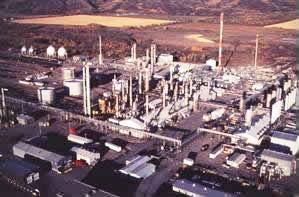 A natural gas processing plant. Essentially all industrial agriculture depends entirely on fertilizers derived from natural gas, just one of many reasons that the energy used to produce industrial food often dwarfs the energy content of the food itself. (Image via Wikipedia)
A natural gas processing plant. Essentially all industrial agriculture depends entirely on fertilizers derived from natural gas, just one of many reasons that the energy used to produce industrial food often dwarfs the energy content of the food itself. (Image via Wikipedia)
Recall that the global average energy consumption (total consumption divided by total world population) is about 48 kWh/day per person. This is the energy equal to burning 20 100w light bulbs for 24 hours. And the average consumption in the US is about six times as much -- burning 120 of those 100w bulbs all day and all night.
But this overlooks a disguised kind energy buying that we all do. The reason it is disguised is that we don't think of these purchases as involving energy at all, because we conceal the energy content of the purchases under another name: calories.
That's right, buying food means buying energy. That's all that food is, actually: one big macronutrient (energy, usually counted in calories) and a variety of micronutrients that the body needs in order to be able to access and use the food to make energy.
And food (energy in plant or animal form) is amazingly energy-dense. 860 food calories -- which you can easily get in a single dessert -- is the energy of 1 kWh, so it's the same energy that would keep 10 of our 100w light bulbs burning for an hour. So if you're on the nominal 2000 calorie diet, your daily energy intake represents 2.33 kWh of your daily energy consumption. If you're a man on the nominal 2500 calorie diet, you consume the equivalent of 2.9 kWh/day in food form.
Thus, a man eating 2500 calories a day and using only 48 kWh/day, the global average, consumes 6% of his daily energy as food, leaving him only 45 kWh left for everything else. His partner, a woman eating 2000 calories a day, uses 5% of the global average daily energy consumption to support her diet.
Where it gets really interesting is when you try to figure out how much energy it took to grow the food, process it, and deliver it to you. That's a complex question that's impossible to answer with certainty; however, numerous groups have tried to estimate this for the US, and the figure that is commonly heard is that every calorie we eat represents about 10 more (mostly from fossil fuels) that were burned delivering that one calorie to us. So our a daily 2500-calorie diet actually demands 25,000 calories, which is 29 kWh (23.25 kWh for the 2000-daily-calorie woman).
Staggering isn't it? The average global citizen only uses 48 kWh per day; in the US, we use 50-60% of that just to feed ourselves, even if we stay in bed all day with no heat or lights on, and certainly not driving or flying or using any electrical devices or tools.

![Reblog this post [with Zemanta]](http://img.zemanta.com/reblog_e.png?x-id=bee2c8e0-e8c9-4e35-844b-bdff0ea94f23)




No comments:
Post a Comment